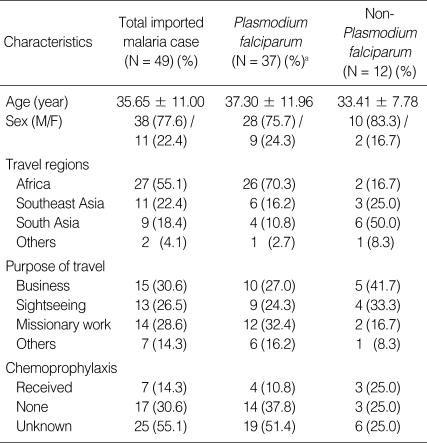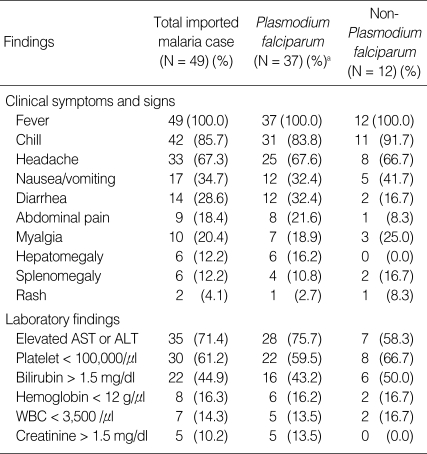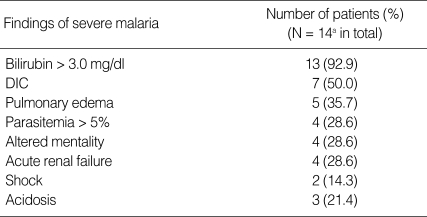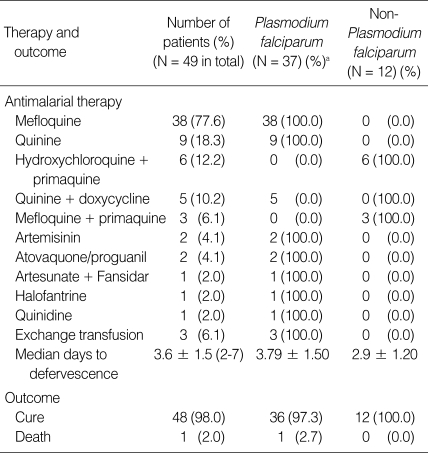Abstract
The incidence of imported malaria has been increasing in Korea. We reviewed data retrospectively to evaluate the epidemiology, clinical features, and outcomes of imported malaria from 1995 to 2007 in a university hospital. All patients diagnosed with imported malaria were included. Imported malaria was defined as a positive smear for malaria that was acquired in a foreign country. A total of 49 patients (mean age, 35.7 year; M : F = 38 : 11) were enrolled. The predominant malarial species was Plasmodium falciparum (73.5%), and the most frequent area of acquisition was Africa (55.1%), followed by Southeast Asia (22.4%) and South Asia (18.4%). Fourteen-patients (30.6%) suffered from severe malaria caused by P. falciparum and 1 patient (2.0%) died of multiorgan failure. Most of the patients were treated with mefloquine (79.2%) or quinine (10.2%); other antimalarial agents had to be given in 13.2% treated with mefloquine and 44.4% with quinine due to adverse drug events (ADEs). P. falciparum was the most common cause of imported malaria, with the majority of cases acquired from Africa, and a significant number of patients had severe malaria. Alternative antimalarial agents with lower rates of ADEs might be considered for effective treatment instead of mefloquine and quinine.
Keywords: Plasmodium, imported malaria, adverse drug events, mefloquine, quinine
Malaria is one of the most severe public health problems world-wide. It is a leading cause of disease and death in many developing countries. An estimated 1 million deaths occur every year due to malaria [1]. Malaria due to Plasmodium vivax, the only naturally occurring human malaria in Korea, was endemic to Korea until the late 1970s, when the country became malaria free. After its first reemergence in 1993, the prevalence of malaria increased exponentially, peaking in 2000, and since then the rates of infection have been decreasing. In total, 21,419 cases were reported between 1993 and 2005 in South Korea [2]. In the 1960s and 1970s, many cases of imported malaria were reported in Korea because of the participation of Korean troops in the Vietnamese War as Allied Forces in 1965 [3]. Recently, an increasing number of Koreans have been traveling to malaria-endemic counties for vacation or missionary works. About 40-80 cases of imported malaria have been diagnosed in South Korea per year [4,5]. However, the above studies reported only the clinical epidemiology of imported malaria in Korea [3,5]. The clinical characteristics and treatment outcomes of imported malaria in South Korea have not been previously reported. We therefore systematically reviewed the clinical characteristics and treatment outcomes of imported malaria, and also assessed the frequency of adverse drug events (ADEs) associated with the first line therapeutic anti-malarial regimens.
Imported malaria was defined as a positive smear for malaria acquired in another country, outside of South Korea. The medical records were retrospectively reviewed among all patients with imported malaria diagnosed at the Samsung Medical Center (SMC) from January 1995 to December 2007. The diagnosis was based on microscopic examination of thick and thin blood smears. Severe malaria was defined according to the World Health Organization (WHO) criteria [6]. We reviewed the electronic database of medical records to analyze the travel history, use of chemoprophylaxis, clinical features, species of Plasmodium detected, complications, treatment, and outcome. The time to defervescence was defined as the interval from initiation of appropriate antimalarial treatment until the documentation of normal body temperature for more than 24 hr.
During the study period, 49 patients were diagnosed with imported malaria in SMC. Thirty-five patients were infected with only Plasmodium falciparum, while 8 patients were diagnosed with only P. vivax infection. There were 2 cases of mixed infections with P. falciparum and P. vivax or P. falciparum and Plasmodium ovale. The exact species of the other cases (N = 4) were undetermined. There were 38 male and 11 female patients. Their age was 35.7 ± 11.0 year (12-58 year). The epidemiological characteristics are described in Table 1. Africa appeared to be the most common region of acquisition of infection (27/47, 55.1%). Business (15/49, 30.6%) was the most common purpose of travel, followed by missionary works (14/49, 28.6%). Table 2 shows the clinical and laboratory findings of the patients at presentation. In all cases, fever was the presenting symptom. At presentation, 35 (71.4%) patients had abnormal liver enzyme levels, and 30 (61.2%) had thrombocytopenia (i.e., platelets < 100,000/µl). According to the WHO severe malaria criteria, 14 patients were classified as having severe malaria: hyperbilirubinemia over 3.0 mg/dl was detected in 13 patients (92.9%), disseminated intravascular coagulation (DIC) in 7 patients (50.0%), pulmonary edema in 5 patients (35.7%) and parasitemia over 5% in 4 patients (28.6%) (Table 3). An exchange transfusion was performed in 3 patients infected with P. falciparum. The median number of days to defervescence was 3.6 days (range 2-7 days). All patients except 1 survived. Mefloquine was the most frequently prescribed medication (38/49, 77.6%). Quinine was used in 9 patients (9/49, 18.4%) (Table 4). Among the mefloquine-treated patients, 7 had gastrointestinal symptoms, such as nausea and vomiting. Among the quinine-treated patients, 5 developed cinchonism, seizures, and vomiting (Table 5). Five patients (13.2%) among the mefloquine-treated group and 4 patients (44.4%) treated with quinine had to be treated with alternative antimalarial agents due to ADEs.
Table 1.
The characteristics of patients with imported malaria
aIncluding 2 mixed infection cases with P. falciparum and P. vivax or P. falciparum and P. ovale.
Table 2.
Clinical and laboratory findings at presentation
aIncluding 2 mixed infection cases.
AST, aspartate aminotransferase; ALT, alanine aminotransferase.
Table 3.
Findings associated with severe malaria
aAll cases are Plasmodium falciparum infection.
DIC, disseminated intravascular coagulation.
Table 4.
Therapy and outcomes of patients with imported malaria
aIncluding 2 mixed infection cases.
Total number exceeds 49 because secondary treatment agents are included.
Table 5.
Adverse events associated with mefloquine and quinine
P. falciparum infection accounted for 70.3% (N = 26) of cases from Africa (all cases developed in sub-Saharan Africa), 16.2% (N = 6) from Southeast Asia, and 10.8% (N = 4) from South Asia. These proportions were similar to the data from the Korean Center for Disease Control and Prevention [4]. Severe malaria attacks occurred in 14 patients infected with P. falciparum. Severe P. falciparum malaria accounted for 64.3% (N = 9), and 35.7% (N = 5) of infections from Southeast or South Asia. Because severe malaria is caused by P. falciparum, rapid diagnosis and effective treatment are very important.
Malaria caused by P. falciparum is becoming resistant to antimalarials. Multidrug resistant malaria is one of the most significant therapeutic problems in Africa and Southeast Asia. Most of the imported malaria identified in this study developed after traveling to Africa or Southeast Asia (77.5%). Therefore, combination treatment is recommended for a first-line treatment of falciparum malaria from Africa and Asia [7]. However, mefloquine may be effective against imported malaria, especially against P. falciparum. In Korea, the oral agent atovaquone-proguanil was introduced a few years ago for the treatment of imported malaria in adults. In order to use intravenous quinine and artesunate, clinicians have to formally request these agents to the National Medical Center. In our study, about 1/5 of the patients who were taking mefloquine had gastrointestinal symptoms, such as nausea and vomiting. ADEs leading to discontinuation of treatment occurred in 13.2% of the patients treated with mefloquine. By contrast, Ki et al. [8] reported that mefloquine based chemoprophylaxis was well tolerated in Korean patients; only 0.6% of patients receiving mefloquine had ADEs. This difference in the frequency of ADEs with mefloquine treatment might be attributed to the difference in the doses used and the patient's general condition.
It is well known that multidrug-resistant falcifarum malaria emerged in Southeast Asia, especially at the border between Thailand and Myanmar or Thailand and Cambodia. Because many Koreans visit Thailand and Cambodia, healthcare-providers must be aware of potential resistance when treating patients returning from these areas [9]. With the increase in international travels, imported malaria might become a more common problem for healthcare providers. Improved educational programs for overseas travelers should help reduce the number of imported malaria cases in Korea. To reduce the morbidity and mortality related to imported malaria, travelers must be informed of the malaria risks, the necessity of chemoprophylaxis, and the importance of immediate medical care if fever develops.
ACKNOWLEDGEMENTS
A part of this study was presented at the 17th International Congress for Tropical Medicine and Malaria (ICTM), Jeju Island, Korea, 2008 (Abstract number P128).
References
- 1.Center for Disease Control and Prevention, Republic of Korea. http://www.cdc.gov/malaria/impact/index.htm.
- 2.Han ET, Lee DH, Park KD, Seok WS, Kim YS, Tsuboi T, Shin EH, Chai JY. Reemerging vivax malaria: changing patterns of annual incidence and control programs in the Republic of Korea. Korean J Parasitol. 2006;44:285–294. doi: 10.3347/kjp.2006.44.4.285. [DOI] [PMC free article] [PubMed] [Google Scholar]
- 3.Seo BS, Lee SH, Yoon JJ, Ryang YS. Parasitological studies of Korean forces in South Vietnam. I. Examination of blood films on malaria patients. Korean J Parasitol. 1970;8:25–29. doi: 10.3347/kjp.1970.8.1.25. [DOI] [PubMed] [Google Scholar]
- 4.Center for Disease Control and Prevention, Republic of Korea. http://www.cdc.go.kr/kcdchome/jsp/home/information/had/INFOHAD0001Detail.jsp?menuid=100053&appid=kcdchome&content=/contents/information/had/b/6312_view.html.
- 5.Soh CT, Lee KT, Im KI, Min DY, Ahn MH, Kim JJ, Yong TS. Current status of malaria in Korea. Yonsei Rep Trop Med. 1985;16:11–18. [Google Scholar]
- 6.World Health Organization, Division of Control of Tropical Diseases. Severe and complicated malaria. Trans R Soc Trop Med Hyg. 1990;84(suppl. 2):1–65. [PubMed] [Google Scholar]
- 7.Greenwood BM, Bojang K, Whitty CJ, Targett GA. Malaria. Lancet. 2005;365:1487–1498. doi: 10.1016/S0140-6736(05)66420-3. [DOI] [PubMed] [Google Scholar]
- 8.Ki HK, Kim YS, Jung SI, Kim S, Peck KR, Song JH. Incidence of mefloquine-related adverse reactions in Korean travelers. J Korean Soc Chemoth. 2000;18:299–306. [Google Scholar]
- 9.Miura T, Kimura M, Koibuchi T, Endo T, Nakamura H, Odawara T, Wataya Y, Nakamura T, Iwamoto A. Clinical characteristics of imported malaria in Japan: analysis at a referral hospital. Am J Trop Med Hyg. 2005;73:599–603. [PubMed] [Google Scholar]







